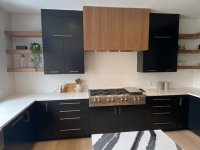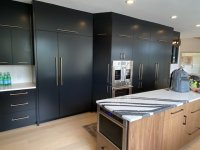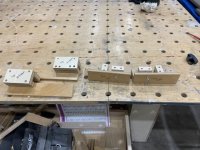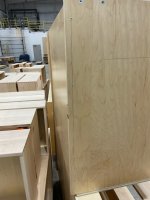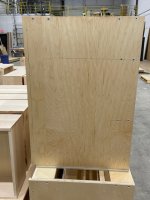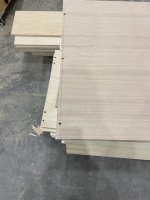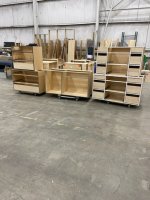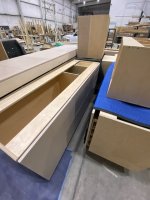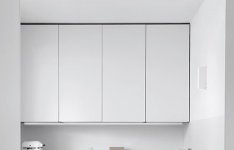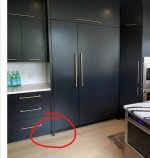The two studies I read were sponsored by the industry groups that represent the flat pack kitchen cabinet companies and the flat pack furniture companies. They only tested joinery that were suitable for high productivity. That left out biscuit joinery and Domino joinery.
Both studies (by different labs, it seems) used similar methods.
They had a vertical panel and a horizontal panel. The vertical panel was rigidly clamped in place. The horizontal panel was joined to the vertical panel on one end only. They then added load to the free end by using something that probably resembled a heavy duty digital fish scale.
My recollection was that they tested dadoes, conventional wood screws, Confirmat screws, quarter turn cam fasteners and dowels.
Cam lock screws and cams:
Note: There are different priorities for flat pack furniture and flat pack cabinets. The cabinets assume that the walls will be a integral part of the structure, so racking side to side is of less importance to the cabinet makers than to the furniture makers.
Both studies concluded that no fastener should be closer than 2” from the edges of the panel. This is probably because you need 2” of space to keep the panel from splitting open.
They tested dadoes (no glue). The horizontal shelf failed at a load that was too low to measure. This was a “moment” for me, as dadoes were my method of construction up until the time I read the studies. Dadoes faired the worst of all the tested joints.
They tested the cam and cam lock screws and that came in second to the last for strength. Pull out strength was OK, but racking strength was lacking.
Conventional screws were slightly better than the cam and cam locks.
Confirmat screws fared much better. They had good pull out strength and all the racking strength of dowels, plus they needed no clamping. But, and a major consideration in my mind, they remain highly visible (and they are expensive).
Dowels had the highest racking strength and can be kept hidden, but require clamping.
When I am building face frame cabinets, I use a combination of Confirmats and dowels.
On a base cabinet, I would use three Confirmats per joint (no glue). After the cabinet is fully assembled, I through drill several more holes and insert dowels with glue. The sides of my cabinets are either hidden or have an end panel so the holes and Confirmats do not show.
I do the same on wall cabinets, but with only two Confirmats.
I suppose that after the glue had dried, I could back out the Confirmats and replace them with dowels. I don’t do that, but I considered it as Confirmat screws are fairly expensive.
This video shows the assembly of a base cabinet, using equipment that is not available to most of us, but is to large manufacturers. A complete cabinet assembled in about 2 minutes. Gang drilling made the holes.
From the manufacturers’ point of view, dowels make the most sense.
I pick and choose. I use pocket holes when racking strength is not required.
I use a combination of dowels (through drilled for face frame cabinets, blind drilled for Euro cabinets) and Confirmats. The Confirmats eliminate the need for clamping. I don’t use staples, and they did not test staples. They did not say why it was not included.



